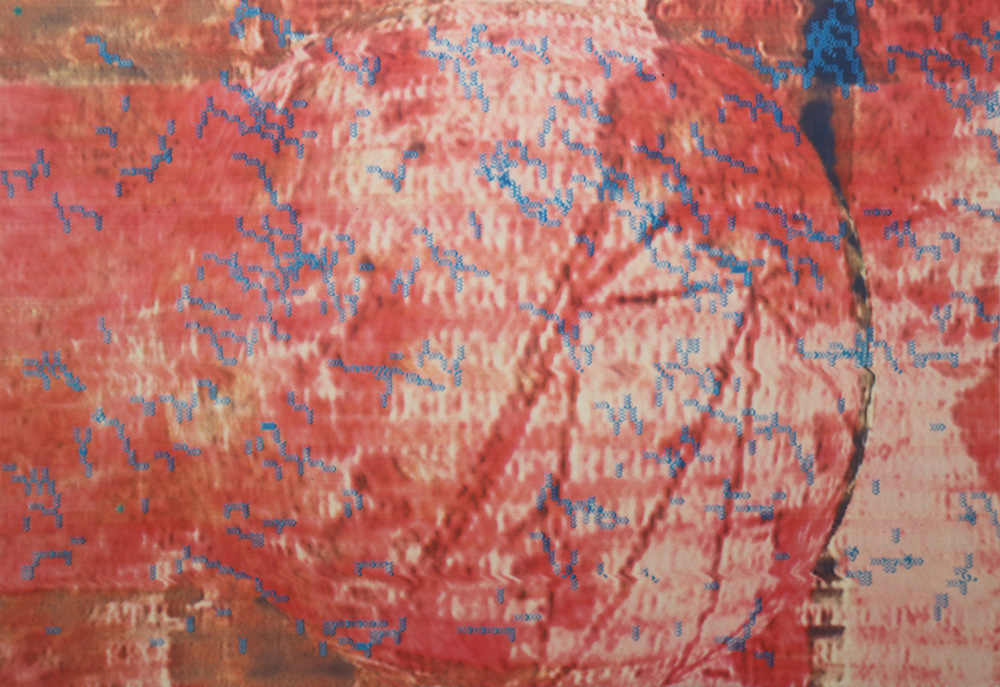NECHVATAL – RICHARD
From September 3rd to October 22, 2016 Galerie Richard presents the seventh solo show by American artist Joseph Nechvatal titled Destroyer of Naivetés: COMPUTER VIRUS 1.0 composed of seven historic 1993 paintings from his HyperCard Computer Virus Project (1992-93) that dealt with the AIDS virus epidemic placed in conjunction with a growing concern for computer viruses.
The 2016 show Destroyer of Naivetés: COMPUTER VIRUS 1.0 picks up on the theme of viral attacks that Nechvatal developed and fleshed out in the early 90s and that appear increasingly relevant now in terms of continuous viral diseases, rampant global terrorism and political cyber hacking. As discussed with Thyrza Goodeve in a recent interview in the January 2016 issue of The Brooklyn Rail, Nechvatal explains that the Computer Virus Project’s initial goal was to produce physical paintings using algorithms that implement a “viral” model in cyberspace. This code as simulation tool allowed him to virtually introduce artificial organisms into a digitized reproduction of an earlier artwork (the host) and let them transform and destroy those images in a ravishingly beautiful manner. During these launched “attacks” in 1993, a new still image was extracted and robotic spay painted on canvas, which is a way to bring back the virtual into the actual. The negative connotations of the HIV virus as a vector of disease is reflected in the principle of degradation that the host image undergoes. But the virus is also the basis of a creative process, producing at times splendor and newness in terms of the history of painting.
Computer Virus Project was created under the umbrella of the FRAC Franche-Comte at the Centre International de Réflexion sur l’Avenir de la Fondation Claude-Nicolas Ledoux at La Saline Royale d’Arc-et-Senans as part of Joseph Nechvatal’s artist-in-residency at Atelier Louis Pasteur in Arbois, France (1991-1993). The original HyperCard (Basic) computer programming was executed in 1992 by Joseph Nechvatal in close collaboration with Jean-Philippe Massonie and Jean-Jacques Girardot at Laboratoire MIS (Université de Franche-Comté). Finished Computer Virus Project artworks were exhibited at Saline Royale, Arc-et-Senans in 1993 and in 1994 at Espace d’Art Yvonamor Palix (Paris), Galerie In Situ (Aalst, Belgium), Brooke Alexander Gallery (New York City) and in 1995 at Galerie Karin Sachs (Munich). In 1996 pieces from Computer Virus Project were exhibited in Joseph Nechvatal Retrospective at Galerie Berndt (Köln) (catalogue). In 2001 the computer animation created as part of Computer Virus Project was exhibited at Moving Image Gallery (New York City) in Transformers, a two-person exhibition with Joseph Nechvatal and Cory Arcangel.
Joseph Nechvatal, whose cross platform work creates deep connections to John Cage’s chance-based art theory, is a post-conceptual artist who has worked with computer technology since 1986. His computer-assisted paintings and animations turn intimate details of the human body into pictorial units that are transformed by digital viruses. This work results in a contamination of the tradition of painting on canvas by artificial life software, thus creating an interface between the virtual and the actual that Nechvatal calls the viractual. Nechvatal’s works are in the collections of MoMA, New York, the Museum of Contemporary Art in Los Angeles, the Jewish Museum, New York, Malmö Kunsthall, Sweden, the Israel Museum in Jerusalem and the Los Angeles County Museum of Art, among others. Nechvatal has recently exhibited at La Biennale di Venezia, Eventi Collaterali. He has published two books of art theory, Towards an Immersive Intelligence: Essay on the Work of Art in the Age of Computer Technology and Virtual Reality 1993-2006 (2009, Edgewise Press) and Immersion Into Noise (2011, University of Michigan Open Humanities Press).
